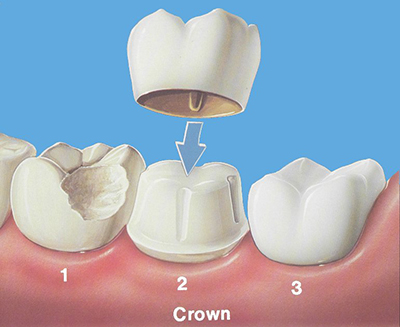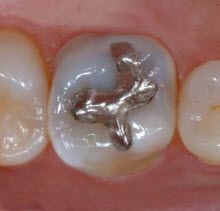
Dental Crowning
Source: : http://strathconadental.ca
I’ve been frequently asked, “What type of filling is the best?” If I had to be honest, I have to admit that I do not know how to answer this question! There is no right or wrong answer as no type of filling is the best for everyone. Basically, what’s right for you will be determined by a number of factors such as the extent of the decay, where in the mouth is the site of tooth decay or whether you are allergic to certain material.
Dental fillings or restorations can be broadly classified into two types; direct restoration and indirect restoration. Direct restoration is a filling done in your mouth during a visit to your dentist whereas indirect restoration is fabricated in a laboratory.

Amalgam Restoration
Source: http://dentistryandmedicine.blogspot.com/
So, let’s take a look. What kind of filling do you have in your mouth? A silver one? Or does your filling match the colour of your teeth? The silver one is called dental amalgam. This material is usually used when the cavity is in your back teeth or when the decay is large. Dental amalgam is a pretty tough material. It is resistant to wear, can handle heavy chewing force and also relatively inexpensive. However, the colour is not very appealing so it is not used in visible areas such as in a front tooth.
You don’t want silver filling in your front teeth? Fret not; there is dental filling that matches the colour of your teeth. This magical material is called composite or resin filling. The paste is directly placed into your cavity, where it is cured and hardened. However, a pretty little thing like this needs regular maintenance. You should avoid coffee, tea, carbonated drinks and tobacco for as long as you can because the composite may become stained over time. Another drawback of composite is that it is not suitable for large cavities as the margins may be chipped over time. Regular polishing is required to maintain the sheen and marginal integrity of composite fillings.

Composite filling
Source: http://www.intelligentdental.com
If, however, the decay or fracture has damaged a large portion of the tooth, indirect restoration such as a crown, inlay or onlay may be needed to satisfactorily restore the tooth into its normal form and function. At this stage, the defect is so large that amalgam or composite cannot cling to the tooth as there is just a small portion of the tooth is left. So a mechanical ‘aid’ has to be placed to facilitate retention of restorative material in the defective tooth. During your visit to the dentist, the dentist will reshape your tooth so that it will be in its best shape to seat the crown. Materials commonly used for indirect restorations are metal, ceramic and a combination of both.
How do you know which type of filling you need? Only your dentist can decide which type of filling is right for you. During your visit, the dentist will closely inspect any signs of abnormalities in your teeth and discuss the best treatment option for you. The type of treatment chosen depends on the extent of the decay and how damaged is the tooth structure.
Dr. Husna Razak (BDS) (KLE VK) is a dental officer working in the Oral and Maxillofacial Surgery Department in Kota Bharu. Know more about her in The Team page.
[This article belongs to The Malaysian Medical Gazette. Any republication (online or offline) without written permission from The Malaysian Medical Gazette is prohibited.]
References:
- http://www.ada.org/3416.aspx
- Phillip’s Science of Dental Materials, 12th Edition
- Sturdevant’s Art and Science of Operative Dentistry, 6th Edition
